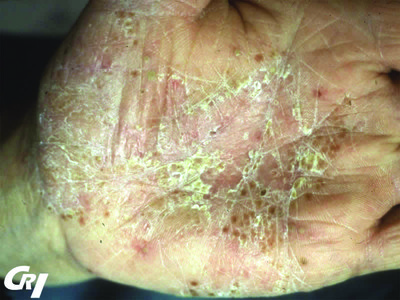Chronic Nonbacterial Osteomyelitis (CNO): Chronic Recurrent Multifocal Osteomyelitis (CRMO); and Synovitis, Acne, Pustulosis, Hyperostosis, Osteitis Syndrome (SAPHO)
Acronym:
CNO/CRMO/SAPHO
SAID group:
Inflammatory Bone Diseases
Gene:
Currently unknown. No genetics tests available (link has OMIM info about genetic research for CRMO.)
Inheritance:
Currently unknown.
Ethnicity:
Affects all races, but the majority of patients have European ancestry. There are more female patients than males. [21] [22]
Frequency:
Unknown, but rare.
Timing of symptoms:
At least 6 months with chronic or relapsing symptoms. Often patients suffer for 7-25 years with symptoms. Many bone lesions heal completely. [19] [22]
Age of onset:
Mostly affects children – some adult onset. Peak incidence of flares is around 10 years of age. [22]
Skin cutaneous:
Some patients have acne, and/or pustulosis on the palms and/or soles of their extremities (palmoplantar pustulosis – often associated with SAPHO). 23% have psoriasis.[19] [22] [54]
Neurologic:
Fevers affect a number of patients during flares of CRMO. Other neurological symptoms are not noted. Some with impaired bone growth, or overall impaired growth.[19] [22] [54]
Auditory:
Not noted. [19] [21] [22] [54]
Ophthalamic:
Some cases of uveitis. [19]
Cardiopulmonary:
Not common–some patients also have ANCA+ vasculitis that can affect the lungs. [18] [54]
Abdominal:
Some patients also have inflammatory bowel diseases. [19]
Lymphatic:
Some cases of ANCA+ vasculitis that can affect the kidneys. [19]
Joints bones muscles cartilage:
Joint swelling, limp, severe bone pain over affected bones (mostly the long bones). Some have jawbone involvement. 2-18 bone lesions are commonly found. Earlier age of onset along with many bone lesions is associated with more severe disease. Bone biopsy and cultures show no infection. [19] [22] Chronic nonbacterial osteomyelitis (CNO) is considered part of the spectrum of bone diseases with CRMO and SAPHO, but may be more self-limiting, and less chronic than CRMO or SAPHO. [115]
Vasculitis:
Some with Takayasu arteritis, or ANCA+ vasculitis. [54]
Amyloidosis:
Not noted. [19] [22] [54]
Abnormal labs:
Whole body MRI can reveal multifocal bone lesions. [20] Normal or elevated WBC, ESR, CRP. [19], [22], [54] Radiographs may appear normal at the start of CNO/CRMO, but an MRI will detect lesions. [81]
Search Keywords:
Chronic Nonbacterial Osteomyelitis, CNO, Chronic Recurrent Multifocal Osteomyelitis, CRMO, Synovitis Acne Pustulosis Hyperostosis Osteitis Syndrome, SAPHO, Inflammatory Bone Diseases, acne, pustulosis, palmoplantar pustulosis, impaired bone growth, growth delay, psoriasis, uveitis, ANCA+ vasculitis, ANCA+, ANCA, Takayasu arteritis, vasculitis, inflammatory bowel disease, IBD, bone pain, bone lesions, multifocal bone lesions, fever bone pain, fever bone lesion, fever bone lesions, fever bone pustulosis, fever bone psoriasis, pustulosis bone, pustulosis bone acne, pustulosis bone inflammatory bowel disease, pustulosis bone vasculitis, pain, leg pain, bone sores, lesions, fever, osteomyelitis, jaw, jawbone, jaw pain, limb pain,

Photo credit:
CRMO: Pr Daniel Wendling (Service de Rhumatologie, Hôpital Jean Minjoz - Besançon) and Pr René-Marc Flipo (CHRU de Lille)
Resources:
Here is a helpful video overview about CNO/CRMO by Dr Polly Ferguson, an expert on CNO/CRMO at the 2nd NIH-WRNMMC Symposium on Autoinflammatory and Immunedysregulatory Diseases that the Autoinflammatory Alliance co-sponsored and helped to organize in August 2019:
Visit our CRMO page on the Autoinflammatory Alliance website.
Visit the CRMO Awareness info page to learn about CNO/CRMO.
Please go to this site for more information on CRMO on the CRMO Foundation site
Updated February 2020 by Karen Durrant RN, BSN

